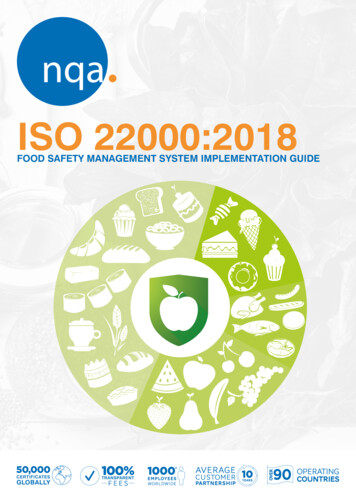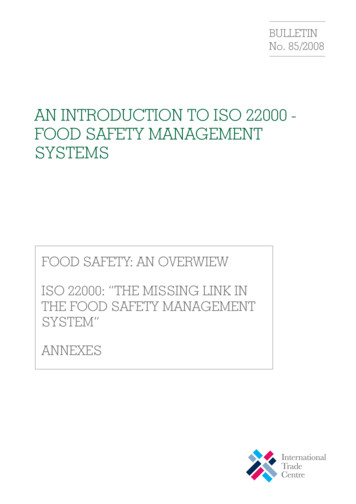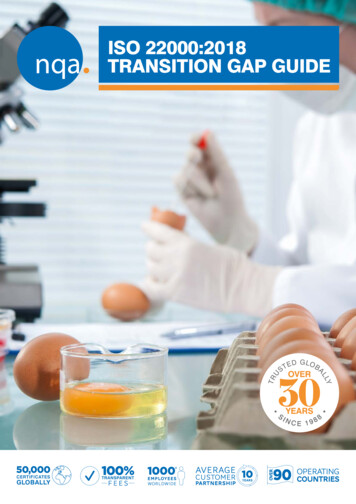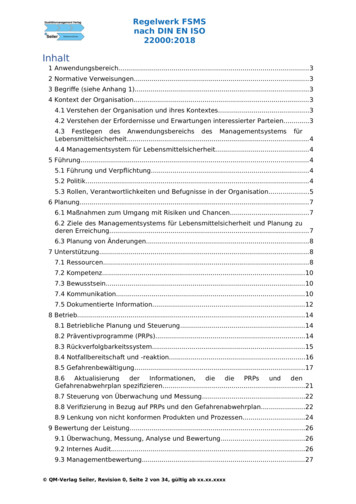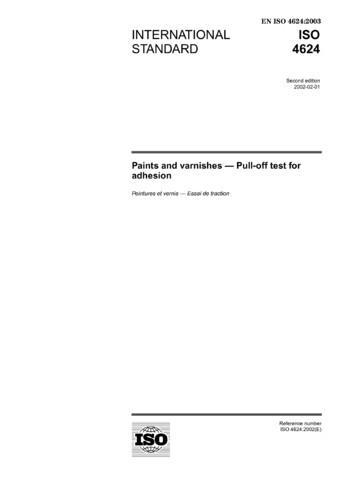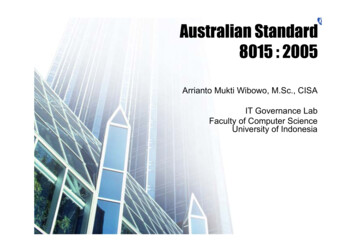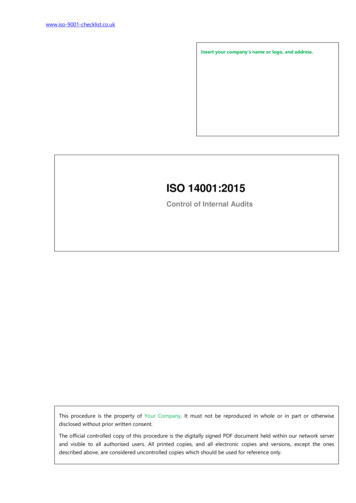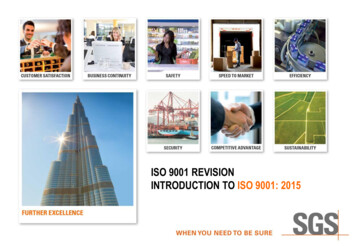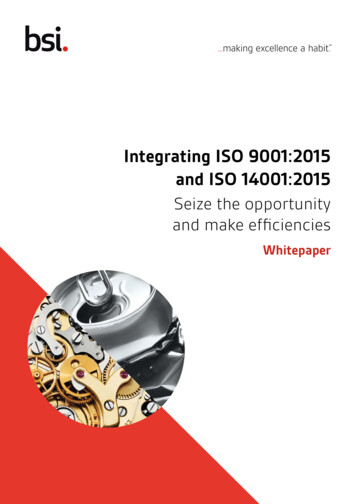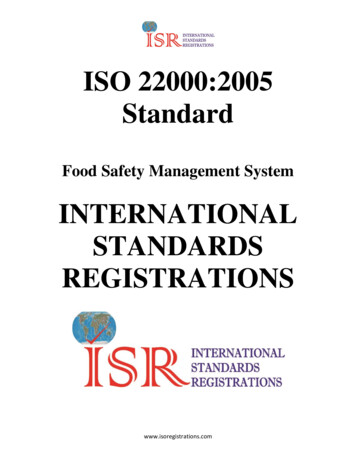
Transcription
ISO 22000:2005StandardFood Safety Management gistrations.com
3.1FOOD SAFETYconcept that food will not cause harm to the consumer when it is prepared and/or eatenaccording to its intended useNOTE 1 Adapted from Reference [11].NOTE 2 Food safety is related to the occurrence of food safety hazards (3.3) and doesnot include other human health aspects related to, for example, malnutrition.3.2 FOOD CHAINsequence of the stages and operations involved in the production, processing,distribution, storage and handling of a food and its ingredients, from primary productionto consumptionNOTE 1 This includes the production of feed for food-producing animals and for animalsintended for food production.NOTE 2 The food chain also includes the production of materials intended to come intocontact with food or raw materials.3.3 - FOOD SAFETY HAZARDbiological, chemical or physical agent in food, or condition of food, with the potential tocause an adverse health effectNOTE 1 Adapted from Reference [11].NOTE 2 The term “hazard” is not to be confused with the term “risk” which, in thecontext of food safety, means a function of the probability of an adverse health effect(e.g. becoming diseased) and the severity of that effect (death, hospitalization, absencefrom work, etc.) when exposed to a specified hazard. Risk is defined in ISO/IEC Guide51 as the combination of the probability of occurrence of harm and the severity of thatharm.NOTE 3 Food safety hazards include allergens.NOTE 4 In the context of feed and feed ingredients, relevant food safety hazards arethose that may be present in and/or on feed and feed ingredients and that maysubsequently be transferred to food through animal consumption of feed and may thushave the potential to cause an adverse human health effect. In the context of operationsother than those directly handling feed and food (e.g. producers of packaging materials,cleaning agents, etc.), relevant food safety hazards are those hazards that can bedirectly or indirectly transferred to food because of the intended use of the providedproducts and/or services and thus can have the potential to cause an adverse humanhealth effect.3.4 - FOOD SAFETY POLICYOverall intentions and direction of an organization related to food safety (3.1) asformally expressed by top managementwww.isoregistrations.com
3.5 - END PRODUCTproduct that will undergo no further processing or transformation by the organizationNOTE A product that undergoes further processing or transformation by anotherorganization is an end product in the context of the first organization and a raw materialor an ingredient in the context of the second organization.3.6 FLOW DIAGRAMschematic and systematic presentation of the sequence and interactions of steps3.7 CONTROL MEASURE food safety action or activity that can be used to prevent or eliminate a food safetyhazard (3.3) or reduce it to an acceptable level NOTE Adapted from Reference [11].3.8 - PRP - PREREQUISITE PROGRAMME food safety basic conditions and activities that are necessary to maintain a hygienicenvironment throughout the food chain (3.2) suitable for the production, handling andprovision of safe end products (3.5) and safe food for human consumptionNOTE The PRPs needed depend on the segment of the food chain in which theorganization operates and the type of organization (see Annex C). Examples ofequivalent terms are: Good Agricultural Practice (GAP), Good Veterinarian Practice(GVP), Good Manufacturing Practice (GMP), Good Hygienic Practice (GHP), GoodProduction Practice (GPP), Good Distribution Practice (GDP) and Good TradingPractice (GTP).3.9 OPERATIONAL PRPOPERATIONAL PREREQUISITE PROGRAMMEPRP (3.8) identified by the hazard analysis as essential in order to control the likelihoodof introducing food safety hazards (3.3) to and/or the contamination or proliferation offood safety hazards in the product(s) or in the processing environment3.10 - CCP - CRITICAL CONTROL POINT food safety step at which control can be applied and is essential to prevent oreliminate a food safety hazard (3.3) or reduce it to an acceptable level NOTE Adaptedfrom Reference [11].3.11 - CRITICAL LIMITcriterion which separates acceptability from unacceptabilityNOTE 1 Adapted from Reference [11].NOTE 2 Critical limits are established to determine whether a CCP (3.10) remains incontrol. If a critical limit is exceeded or violated, the products affected are deemed to bepotentially unsafe.www.isoregistrations.com
3.12 MONITORINGconducting a planned sequence of observations or measurements to assess whethercontrol measures (3.7) are operating as intended3.13 CORRECTIONaction to eliminate a detected nonconformity [ISO 9000:2000, definition 3.6.6] NOTE 1For the purposes of this International Standard, a correction relates to the handling ofpotentially unsafe products, and can therefore be made in conjunction with a correctiveaction (3.14).NOTE 2 A correction may be, for example, reprocessing, further processing, and/orelimination of the adverse consequences of the nonconformity (such as disposal forother use or specific labeling).3.14 CORRECTIVE ACTIONaction to eliminate the cause of a detected nonconformity or other undesirable situationNOTE 1 There can be more than one cause for a nonconformity. [ISO 9000:2000,definition 3.6.5]NOTE 2 Corrective action includes cause analysis and is taken to prevent recurrence.3.15 - VALIDATION food safety obtaining evidence that the control measures (3.7) managed by theHACCP plan and by the operational PRPs (3.9) are capable of being effectiveNOTE This definition is based on Reference [11] and is more suitable for the field offood safety3.16 - VERIFICATIONconfirmation, through the provision of objective evidence, that specified requirementshave been fulfilled3.17 - UPDATINGimmediate and/or planned activity to ensure application of the most recent information4 FOOD SAFETY MANAGEMENT SYSTEM4.1 GENERAL REQUIREMENTSThe organization shall establish, document, implement and maintain an effective foodsafety management system and update it when necessary in accordance with therequirements of this International Standard.The organization shall define the scope of the food safety management system. Thescope shall specify the products or product categories, processes and production sitesthat are addressed by the food safety management system.www.isoregistrations.com
The organization shalla) ensure that food safety hazards that may be reasonably expected to occur in relationto products within the scope of the system are identified, evaluated and controlled insuch a manner that the products of the organization do not, directly or indirectly, harmthe consumer,b) communicate appropriate information throughout the food chain regarding safetyissues related to its products,c) communicate information concerning development, implementation and updating ofthe food safety management system throughout the organization, to the extentnecessary to ensure the food safety required by this International Standard, andd) evaluate periodically, and update when necessary, the food safety managementsystem to ensure that the system reflects the organization's activities and incorporatesthe most recent information on the food safety hazards subject to control.Where an organization chooses to outsource any process that may affect end productconformity, the organization shall ensure control over such processes. Control of suchoutsourced processes shall be identified and documented within the food safetymanagement system.4.2 DOCUMENTATION REQUIREMENTS4.2.1 GENERALThe food safety management system documentation shall includea) documented statements of a food safety policy and related objectives (see 5.2),b) documented procedures and records required by this International Standard, andc) documents needed by the organization to ensure the effective development,implementation and updating of the food safety management system.4.2.2 CONTROL OF DOCUMENTSDocuments required by the food safety management system shall be controlled.Records are a special type of document and shall be controlled according to therequirements given in 4.2.3.The controls shall ensure that all proposed changes are reviewed prior toimplementation to determine their effects on food safety and their impact on the foodsafety management system.A documented procedure shall be established to define the controls neededa) to approve documents for adequacy prior to issue,b) to review and update documents as necessary, and re-approve documents,c) to ensure that changes and the current revision status of documents are identified,d) to ensure that relevant versions of applicable documents are available at points ofuse,e) to ensure that documents remain legible and readily identifiable,www.isoregistrations.com
f) to ensure that relevant documents of external origin are identified and their distributioncontrolled, andg) to prevent the unintended use of obsolete documents, and to ensure that they aresuitably identified as such if they are retained for any purpose.4.2.3 Control of recordsRecords shall be established and maintained to provide evidence of conformity torequirements and evidence of the effective operation of the food safety managementsystem. Records shall remain legible, readily identifiable and retrievable. A documentedprocedure shall be established to define the controls needed for the identification,storage, protection, retrieval, retention time and disposition of records.5 MANAGEMENT RESPONSIBILITY5.1 MANAGEMENT COMMITMENTTop management shall provide evidence of its commitment to the development andimplementation of the food safety management system and to continually improving itseffectiveness bya) showing food safety is supported by the business objectives of the organization,b) communicating to the organization the importance of meeting the requirements of thisInternational Standard, any statutory and regulatory requirements, as well as customerrequirements relating to food safety,c) establishing the food safety policy,d) conducting management reviews, ande) ensuring the availability of resources.5.2 FOOD SAFETY POLICYTop management shall define, document and communicate its food safety policy.Top management shall ensure that the food safety policya) is appropriate to the role of the organization in the food chain,b) conforms with both statutory and regulatory requirements and with mutually agreedfood safety requirements of customers,c) is communicated, implemented and maintained at all levels of the organization,d) is reviewed for continued suitability (see 5.8),e) adequately addresses communication (see 5.6), andf) is supported by measurable objectives.5.3 FOOD SAFETY MANAGEMENT SYSTEM PLANNINGTop management shall ensure thata) planning of the food safety management system is carried out to meet requirementsgiven in 4.1 as well as the objectives of the organization that support food safety, andb) the integrity of the food safety management system is maintained when changes tothe food safety management system are planned and implemented.www.isoregistrations.com
5.4 RESPONSIBILITY AND AUTHORITYTop management shall ensure that responsibilities and authorities are defined andcommunicated within the organization to ensure the effective operation andmaintenance of the food safety management system. All personnel shall haveresponsibility to report problems with the food safety management system to identifiedperson(s). Designated personnel shall have defined responsibility and authority toinitiate and record actions.5.5 FOOD SAFETY TEAM LEADERTop management shall appoint a food safety team leader who, irrespective of otherresponsibilities, shall have the responsibility and authoritya) to manage a food safety team (see 7.3.2) and organize its work,b) to ensure relevant training and education of the food safety team members (see6.2.1),c) to ensure that the food safety management system is established, implemented,maintained and updated, andd) to report to the organization's top management on the effectiveness and suitability ofthe food safety management system.NOTE The responsibility of the food safety team leader may include liaison with externalparties on matters relating to the food safety management system.5.6 COMMUNICATION5.6.1 EXTERNAL COMMUNICATIONTo ensure that sufficient information on issues concerning food safety is availablethroughout the food chain, the organization shall establish, implement and maintaineffective arrangements for communicating witha) suppliers and contractors,b) customers or consumers, in particular in relation to product information (includinginstructions regarding intended use, specific storage requirements and, as appropriate,shelf life), enquiries, contracts or order handling including amendments, and customerfeedback including customer complaints,c) statutory and regulatory authorities, andd) other organizations that have an impact on, or will be affected by, the effectiveness orupdating of the food safety management system. Such communication shall provideinformation on food safety aspects of the organization's products that may be relevant toother organizations in the food chain. This applies especially to known food safetyhazards that need to be controlled by other organizations in the food chain. Records ofcommunications shall be maintained. Food safety requirements from statutory andregulatory authorities and customers shall be available. Designated personnel shallhave defined responsibility and authority to communicate externally any informationwww.isoregistrations.com
concerning food safety. Information obtained through external communication shall beincluded as input to system updating (see 8.5.2) and management review (see 5.8.2).5.6.2 INTERNAL COMMUNICATIONThe organization shall establish, implement and maintain effective arrangements forcommunicating with personnel on
ISO 22000:2005 Standard Food Safety Management System INTERNATIONAL STANDARDS REGISTRATIONS . www.isoregistrations.com 3.1 FOOD SAFETY concept that food will not cause harm to the consumer when it is prepared and/or eaten according to its intended use NOTE 1 Adapted from Reference [11]. NOTE 2 Food safety is related to the occurrence of food safety hazards (3.3) and does

